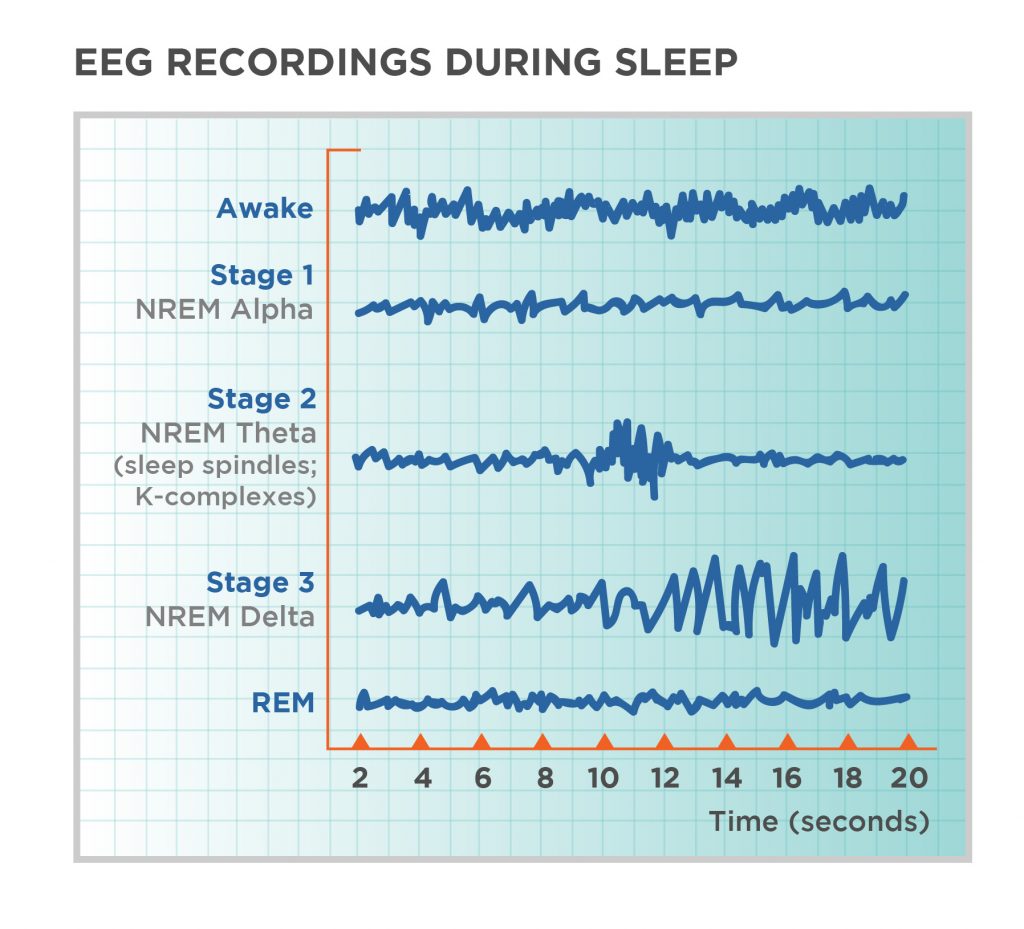What Are the Stages of Sleep?
There are four stages of sleep: Non-REM (NREM) sleep (Stages 1, 2 & 3) and REM sleep. Periods of wakefulness occur before and intermittently throughout the various sleep stages or as one shifts sleeping position.
Wake is the period when brain wave activity is at its highest and muscle tone is active.
Stage 1 is the lightest stage of NREM sleep. Often defined by the presence of slow eye movements, this drowsy sleep stage can be easily disrupted causing awakenings or arousals. Muscle tone throughout the body relaxes and brain wave activity begins to slow from that of wake. Occasionally people may experience hypnic jerks or abrupt muscle spasms and may even experience sensation of falling while drifting in and out of Stage 1.
Stage 2 is the first actual stage of defined NREM sleep. Awakenings or arousals do not occur as easily as in Stage 1 sleep and the slow moving eye rolls discontinue. Brain waves continue to slow with specific bursts of rapid activity known as sleep spindles intermixed with sleep structures known as K complexes. Both sleep spindles and K complexes are thought to serve as protection for the brain from awakening from sleep. Body temperature begins to decrease and heart rate begins to slow.
Stage 3 is known as deep NREM sleep. The most restorative stage of sleep, stage 3 consists of delta waves or slow waves. Awakenings or arousals are rare and often it is difficult to awaken someone in Stage 3 sleep. Parasomnias (sleepwalking, sleep talking or somniloquy and night terrors) occur during the deepest stage of sleep.
REM sleep, also known as rapid eye movement, is most commonly known as the dreaming stage. Eye movements are rapid, moving from side to side and brain waves are more active than in Stages 2 & 3 of sleep. Awakenings and arousals can occur more easily in REM; being woken during a REM period can leave one feeling groggy or overly sleepy.
Stages of the Sleep Cycle
| WAKE | LIGHT SLEEP | LIGHT SLEEP | DEEP SLEEP | REM SLEEP | |
| Stage of Sleep: | Stage 0 | Stage 1 | Stage 2 | Stage 3 | Stage R |
| Description: | Eyes open, responsive to external stimuli, can hold intelligible conversation | Transition between waking and sleep. If awakened, person will claim was never asleep. | Main body of light sleep. Memory consolidation. Synaptic pruning. | Slow waves on EEG readings. | Brain waves similar to waking. Most vivid dreams happen in this stage. Body does not move. |
| Time Spent In: | 16 to 18 hours per day | 4 to 7 hours per night | 90 to 120 min/night |
What Is a Sleep Cycle?
A sleep cycle is the progression through the various stages of NREM sleep to REM sleep before beginning the progression again with NREM sleep. Typically, a person would begin a sleep cycle every 90-120 minutes resulting in four to five cycles per sleep time, or hours spent asleep.
One does not go straight from deep sleep to REM sleep, however. Rather, a sleep cycle progress through the stages of non-REM sleep from light to deep sleep, then reverse back from deep sleep to light sleep, ending with time in REM sleep before starting over in light sleep again.
For a majority of people, a sleep cycle begins with a short period of Stage 1 sleep whereby the body begins to relax and a drowsy state occurs with slow rolling eye movements. Though arousals or awakenings are prevalent, Stage 1 is important as it allows for the body to enter Stage 2; the first quantifiable stage of NREM sleep.
Stage 2 occurs for longer periods than Stage 1. For most, Stage 2 sleep comprises approximately 40-60% of total sleep time.
Moving through the sleep cycle, Stage 3 is most often found next in the progression. This restorative stage does not last as long as Stage 2, lasting between 5-15% of total time asleep for most adults. For children and adolescents Stage 3 is much higher in duration.
REM can occur at at time during the sleep cycle, but on average it begins 90 minutes following sleep onset and is short in duration as it is the first REM period of the night. Following REM, the process resumes starting with periods of Stage 1, 2 & 3 intermixed before returning to REM again for longer periods of time as sleep time continues.
How long is a sleep cycle? The first sleep cycle takes about 90 minutes. After that, they average between 100 to 120 minutes. Typically, an individual will go through four to five sleep cycles a night.
What Is Deep Sleep?
Deep sleep occurs in Stage 3 of NREM sleep. Brain waves during Stage 3 are called delta waves due to the slow speed and large amplitude. Of all of the sleep stages, Stage 3 is the most restorative and the sleep stage least likely to be affected by external stimuli.
Waking a person from deep sleep can be difficult. Following a period of sleep deprivation, a person experiences extensive time in Stage 3 sleep. Parasomnias such as sleep walking, sleep talking, night terrors and bedwetting can occur. (There is muscle activity, that’s how people can talk or kick in their sleep!)
Deep sleep reduces your sleep drive, and provides the most restorative sleep of all the sleep stages. This is why if you take a short nap during the day, you’re still able to fall asleep at night. But if you take a nap long enough to fall into deep sleep, you have more difficulty falling asleep at night because you reduced your need for sleep.
During deep sleep, human growth hormone is released and restores your body and muscles from the stresses of the day. Your immune system also restores itself. Much less is known about deep sleep than REM sleep. It may be during this stage that the brain also refreshes itself for new learning the following day.
When Does REM Sleep Occur?
A person’s sleep time (approximately 6-8 hours for adults) can be thought of as 2 halves. The first half for a majority of people consists mostly of Stages 2 and 3 with sporadic periods of Stage 1 and short REM periods. As the night progresses, Stage 3 begins to diminish in quantity while Stages 1 and 2 remain with lengthening periods of REM occurring.
A person typically experiences three to five REM periods throughout sleep time with the longest REM period right before awakening for the day. If woken prematurely from completing the REM period a person can experience a period of sleep inertia whereby a heightened sensation of sleepiness can occur for several minutes or even several hours.
In the REM period, breathing becomes more rapid, irregular and shallow, eyes jerk rapidly and limb muscles are temporarily paralyzed. Brain waves during this stage increase to levels experienced when a person is awake. Also, heart rate increases, blood pressure rises, males develop erections and the body loses some of the ability to regulate its temperature.
In What Stage of Sleep Do Dreams Occur?
As an active sleep state, REM is the time when the most vivid dreams occur. The rapid eye movements that occur can be seen as sharp, rapid movements. Brain waves during REM sleep are considered to be of low amplitude and mixed frequency consistent with higher activity than that seen in Stages 2 and 3.

A person may dream 4 to 6 times each night. A French study found that all people do in fact dream, whether they remember their dreams or not. However, if awoken during REM sleep, a person often can remember their dreams.
Muscle paralysis often accompanies REM sleep. This muscle atonia or muscle paralysis occurs as a protective means to keep one from acting out their dreams. Obstructive Sleep Apnea is often the worst during REM periods due to the lack of muscle tone within the muscles of the airway. Scientists believe this may be to help prevent us from injury while trying to act out our dreams.
During REM respirations are irregular and shallow and irregularities in heart rate and body temperature also occur.
Brain Waves During REM and Non-REM Sleep
As sleep research is still a relatively young field, scientists did not discover REM sleep until 1953 when new machines were developed to monitor brain activity. Before this discovery it was believed that most brain activity ceased during sleep. Since then, scientists have also disproved the idea that deprivation of REM sleep can lead to insanity and have found that lack of REM sleep can alleviate clinical depression although they do not know why. Recent theories link REM sleep to learning and memory.
Brain Waves During the Sleep Cycle
| STAGE | FREQUENCY (HZ) | AMPLITUDE (MICRO VOLTS) | WAVEFORM TYPE |
| awake | 15-50 | <50 | |
| pre-sleep | 8-12 | 50 | alpha rhthym |
| 1 | 4-8 | 50-100 | theta |
| 2 | 4-15 | 50-150 | splindle waves |
| 3 | 1-4 | 100-200 | spindle waves and slow waves |
| REM | 15-30 | <50 |
How Your Sleep Cycle Changes With Age
Sleep changes throughout a person’s life. From a newborn, through toddler years, school age, adolescent and adulthood, sleep is changing.
Newborn (0 – approximately 4 months)
Do not have distinctive sleep waves. Sleep is categorized as “Active”, “Quiet” and “Indeterminate”. Active sleep is the equivalent to REM sleep and quiet sleep is equivalent to non-REM sleep. A majority of the time, newborns are in active sleep which allows for frequent arousals or awakenings; this is necessary for regular periods of feeding.
Infants (Approximately 4 months – 1 year)
Standard sleep stage distinction is now apparent. Sleep becomes more consolidated and sleeping routines can be developed, sleep is typically 10-13 hours per 24 hour period with 2-3 daytime naps occuring.
Toddlers (1 year – 3 years)
With sleeping patterns fully developed, children spend approximately 25% in Stage 3 deep sleep with almost an equal amount of time in REM. Average sleep time is 9.5-10.5 hours per 24 hour period. Typically naps will reduce to 1 per day most likely occurring early in the afternoon to allow for proper nighttime sleep.
Pre-School (3 – 6 years)
Sleep time is similar to that of toddlers, approximately 9-10 hours per 24 hour period. The afternoon nap usually subsides around 3-4 years for a majority of children. Stage 3 sleep still remains high in relation to total sleep time.
School Age (6 years – 12 years)
Sleep time remains unchanged; 9-10 hours per 24 hour period and Stage 3 remains approximately 20-25% of total sleep time. Restorative sleep is important for growth and development.
Adolescent (12 years and beyond)
Sleep time for adolescents is approximately 9-9.5 hours per 24 hour period. There are physiological changes in circadian rhythm that occur causing sleep onset to be later. This internal shift is is the cause for many adolescents to have later lights out and the desire to want to “sleep in” in the morning. As a person ages, the circadian rhythm shifts back and sleep again appears to regulate to approximately 6.5-8 hours of sleep per 24 hour period as adult.


